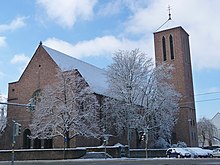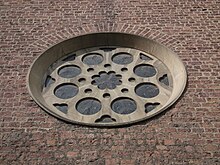St. Albert (Heidelberg)
St. Albert is the Catholic parish church in the Bergheim district of Heidelberg . It was built between 1933 and 1935 according to plans by Franz Sales Kuhn and is dedicated to St. Albertus Magnus .
history
The village of Bergheim, which was dissolved in 1392, was not rebuilt as a Heidelberg district until the end of the 19th century. The Catholic Church of the new district was built at the southern end of the Ernst Walz Bridge , which opened in 1928 . It was designed by Franz Sales Kuhn, who had already designed the old indoor swimming pool and other public and private buildings in Heidelberg and who had delivered an unrealized design for St. Bonifatius . The building site for the church and the area adjoining Bergheimer Strasse to the south (Albertusplatz, since 2002 Alfons-Beil-Platz) had previously been the city’s measuring site . A new one was built in 1931, together with a parade ground, not far from the old location, on the Neckar, adjacent to the loading facility of the Weber gravel dredger.
The groundbreaking ceremony took place on May 29, 1933, and the first service was celebrated in November 1934. On May 26, 1935, the Freiburg auxiliary bishop Wilhelm Burger consecrated the church. St. Albert had been a curate since 1936, and an independent parish was established in 1948. Alfons Beil was the curate and long-time pastor of St. Albert . From 2005 the parish formed the pastoral care unit Philipp Neri together with St. Bonifatius in the west town and St. Michael in the south town . St. Albert has been part of the Philipp Neri community since 2015.
In 1960/61 the church was renovated and redesigned, the original altar structure was removed, the rose window in the choir was bricked up and a large mural was attached instead. In 2002, the 700-person interior was reorganized in response to the smaller community.
description
architecture
After the numerous historic church new buildings at the turn of the century, St. Albert is considered the first modern church building in Heidelberg. The listed church is oriented to the west with the main portal to Mittermaierstrasse, the ship is parallel to the Neckar. Below the church is the parish hall with the same dimensions. The building, made of small rubble stones, has clear cubic forms, the narrow lancet windows and the rose window above the portal cite Gothic styles.
inner space
The interior is a single-nave, flat-roofed hall with side wall tongues with arched openings. The monumental altarpiece created by Rudolf Kaufhold in 1961 shows Christ enthroned in a mandorla , surrounded by angels, prophets, the symbols of the evangelists and the holy Albertus Magnus, the church patron, represented as a monk, bishop and natural scientist. The altar cross, tabernacle and candlestick are by Theo Kämper. During the redesign in 2002, the people's altar was moved far into the church interior on a movable altar island and the pews aligned with it from three sides.
organ
The organ was built from 1938 to 1947 by Willy Dold from Freiburg. It has 32 registers on two manuals and a pedal . It represents a synthesis between the German and French organ romanticism of the 19th century and follows the principles of the organ movement . The open organ prospect fits into the gallery and surrounds the rose window. The actions are electro-pneumatic.
|
|
|
||||||||||||||||||||||||||||||||||||||||||||||||||||||||||||||||||||||||||||||||||||||||||||||||||||||||||||||
-
Couple
- Normal coupling: II / I, I / P, II / P
- Sub-octave coupling: II / I, II / II
- Super octave coupling: I / I, II / I, II / II, II / P
- Playing aids: two free combinations, fixed combinations (p, mf, f, tutti, Generalmutti), register crescendo, put down
- annotation
- (WA No. 37) = wind weakening
literature
- Hans Gercke: Churches in Heidelberg . 1st edition. Schnell and Steiner, Regensburg 2011, ISBN 978-3-7954-2413-8 .
- State Office for Monument Preservation (publisher): Monument topography Federal Republic of Germany, cultural monuments in Baden-Württemberg, city district of Heidelberg , Thorbecke-Verlag 2013, ISBN 978-3-7995-0426-3
Web links
- St. Albert: Our church in the Heidelberg City Church
- Liturgical redesign of the Church of St. Albert (Archbishop's Building Office Heidelberg) ( Memento from February 10, 2013 in the web archive archive.today )
- Restoration of the organ (Orgelbau Lenter)
Individual evidence
- ↑ Squares and green spaces in Heidelberg south of the Neckar on the website of the Heidelberg History Association, accessed on August 1, 2014
- ↑ City map of Heidelberg from 1927 ( Memento of the original from August 8, 2014 in the Internet Archive ) Info: The archive link was automatically inserted and not yet checked. Please check the original and archive link according to the instructions and then remove this notice. , Grieben-Verlag, on the Landkartenarchiv.de website, accessed on August 1, 2014
- ↑ Information about the organ and the disposition
Coordinates: 49 ° 24 ′ 30.9 " N , 8 ° 40 ′ 34.2" E


